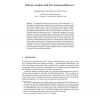Free Online Productivity Tools
i2Speak
i2Symbol
i2OCR
iTex2Img
iWeb2Print
iWeb2Shot
i2Type
iPdf2Split
iPdf2Merge
i2Bopomofo
i2Arabic
i2Style
i2Image
i2PDF
iLatex2Rtf
Sci2ools
147
click to vote
CAV
2011
Springer
2011
Springer
Malware Analysis with Tree Automata Inference
Abstract. The underground malware-based economy is flourishing and it is evident that the classical ad-hoc signature detection methods are becoming insufficient. Malware authors seem to share some source code and malware samples often feature similar behaviors, but such commonalities are difficult to detect with signature-based methods because of an increasing use of numerous freelyavailable randomized obfuscation tools. To address this problem, the security community is actively researching behavioral detection methods that commonly attempt to understand and differentiate how malware behaves, as opposed to just detecting syntactic patterns. We continue that line of research in this paper and explore how formal methods and tools of the verification trade could be used for malware detection and analysis. We propose a new approach to learning and generalizing from observed malware behaviors based on tree automata inference. In particular, we develop an algorithm for inferring k-testa...
| Added | 25 Aug 2011 |
| Updated | 25 Aug 2011 |
| Type | Journal |
| Year | 2011 |
| Where | CAV |
| Authors | Domagoj Babic, Daniel Reynaud, Dawn Song |
Comments (0)

